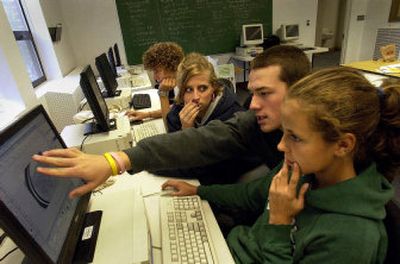New style of school

Thirteen-year-old Bryanna Merrill is making plans to open her own coffee shop this year. The freshman student at the Rivercity Leadership Academy, West Valley’s new project-based high school, will use math skills to get the venture off the ground, and will learn about business and marketing along the way. She may even use scientific formulas to determine how to make the perfect cup of joe, and geography to determine where the best coffee beans come from.
Merrill will get high school credit for her entrepreneurial effort, the first of many projects she plans to put into action during her high school career.
“I have a list of ideas that could probably fill 20 pages,” Merrill said.
Merrill is one of 22 students in grades nine through 12 enrolled in the project high school, though West Valley is hoping to recruit at least 20 more this year.
The school is modeled after a Minnesota charter school, where students like Merrill complete hands-on projects to fulfill graduation requirements in lieu of traditional classroom work.
The school is funded in part through a grant West Valley received from a Minnesota-based education cooperative linked to the Gates Foundation, and is open to any high school student in the area. West Valley is the first public school in Washington to replicate the model.
“Student competency is based on assessment rather than seat time,” said Chris Sande, one of two teachers hired to oversee the West Valley school. All projects will strictly adhere to the essential academic learning requirements put forth by the state, which map out what students should know and when. Rivercity students also must pass the Washington Assessment of Student Learning to graduate from high school.
“The projects will be measure in hours, showing that they’ve met so many hours of credit once the project is complete,” Sande said.
Though school has been in session for almost two months, the school itself is still a project in the making.
The school does not have a principal making the day-to-day decisions. The two teachers, Sande and Eric Christianson, are the “teacher owners,” and have the power to hire and fire staff, though ultimately they still answer to the West Valley board of directors.
The teachers also came up with a creative framework for the school, which includes an emphasis on technology and the outdoors, with an entrepreneurial mindset.
“The learning really takes place outside the walls of the school,” Christianson said.
Some classes, like math, however, are still being taught in the traditional environment, though even the traditional model looks nontraditional in this school. Each morning the students sit around a conference table, facing one another while Sande goes over the day’s math lessons.
To track the progress of the students, each student is required to write about what they did that day in an electronic journal. If they don’t write in it, they can’t go back and do it later, Sande said.
“We’re still in the creative process of what it all will look like,” Sande said. “But we’re doing that with the students, which is very exciting. It gives them a sense of ownership.”
The first class of 22 at the school started out the year with a “boot camp,” where students spent a few days in the outdoors learning leadership skills.
“It gets them out of their comfort zone; gets them thinking,” Sande said. “They learn to rely on one another.”
The next week was spent at Camp Reed north of Spokane, where the students assembled computers donated to the school by the Internal Revenue Service in Seattle. The IRS donated enough IBM personal computers to fill a lab, which is currently being housed at the Millwood School west of Argonne Road on Grace Avenue, and enough so that every student could also take one home.
Also at the camp, students were asked to come up with their own form of student government, and the school’s mascot (Wolfpack) and colors (charcoal gray, white, and navy blue).
The student government is based on the National Outdoor Leadership School model. Students are divided into four quadrants of leadership based on their strengths and weaknesses. The quadrants include the motivators (goals), decision makers (rules), fact-finding analysts (judicial), and the relationship masters.
One student, Liz Stockton, a senior who transferred to the project school from University High School, was selected by the other students to be the “alpha leader.”
“We had a great start; we had an opportunity to get to know each other, where if you were sitting the classroom, we never would have had that chance,” Stockton said. “The social aspect of what draws people to school is definitely here; we’re not missing out on anything.”